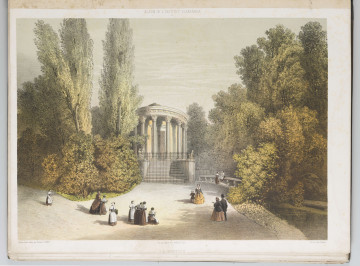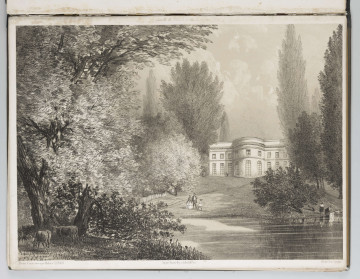
La Sybylle
1860
National Museum in Lublin
Part of the collection: Lubliniana. Painting views of Lublin and the Lublin Region (17th–early 20th c.)
The Sybil Temple in Puławy was one of the most interesting buildings constructed by Chrystian Piotr Aigner (1756-1841), an outstanding Polish architect, son of a carpenter from the Puławy factory. This was due to an exceptionally picturesque location of the pavilion on a high escarpment over the old river bed of the Vistula, and also due to the inspiration of a beautiful, antique model of the building - the Temple of Vesta in Tivoli, standing on a rock cliff. The cylindrical body with two storeys with the lower one strengthened with scarps, which is at the same time the foundation for the upper one, surrounded with a colonnade, looked particularly picturesque from the side of the Vistula riverbank. Immersed in lush vegetation, it dominated the southern part of the park, being an important view point over the Vistula river valley and the meadow lying in it, as well as Kępa, where theatrical performances took place. The pavilion was erected in the years 1798-1801 in order to house the valuable Polish antiquities collected with great passion by Izabela Czartoryska. Initially the Duchess called it a temple, then it was called the Temple of Remembrance or the Temple of Memorabilia, with time it was referred to as the Temple of Sybil. The main idea of this place is contained in the sentence above the entrance “THE PAST OF THE FUTURE”, taken from the statement of Prince Adam Kazimierz “The past should be the master of the future”. The memorabilia gathered in the upper room were to “glorify the names of great men” and recall the great history of the Polish nation, giving it comfort in times of captivity and hope for independence. A similar role was fulfilled by the memorial shields of Polish hetmans and victorious commanders placed in the lower room, as well as the obelisk in honour of Prince Jozef Poniatowski, who was highly worshipped in Puławy. An apologia for the Polish army as well as upbeat motifs were emphasized by Aleksander Linowski in his ode Invocation to the Temple at its opening:
Here we can recall what we once were.
Sobieski's helmet or the mute Jagged Sword
seem to say: “Poles, oppressed by harsh sufferings,
lift your spirits with a more glorious past!”.
The temple of national remembrance in Puławy, created by Duchess Izabela, was the first Polish museum, officially opened in 1801. The park pavilion intended for this purpose was one of the first original museum buildings in the world.
Renata Bartnik
Author / creator
Dimensions
cały obiekt: height: 32,8 cm, width: 43,8 cm
Object type
graphics
Technique
lithography
Material
paper
Creation time / dating
Creation / finding place
Owner
The National Museum in Lublin
Identification number
Location / status

1860
National Museum in Lublin

1860
National Museum in Lublin

1860
National Museum in Lublin
DISCOVER this TOPIC
Museum of King Jan III's Palace at Wilanów
DISCOVER this PATH
Educational path